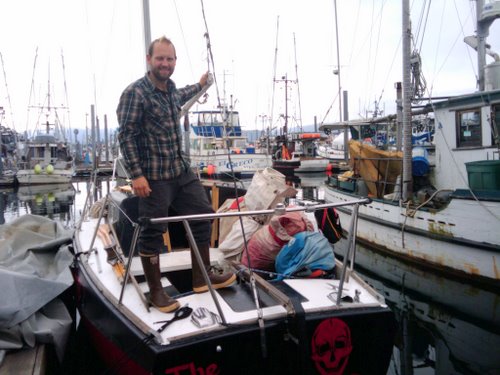Sitka’s waters are cleaner thanks to the Jolly Roger and its Coastal Footprint Crew. So far the crew and its captain, Louis Hoock, have ventured out to Brent’s beach and the Apple Islands where they collected over five hundred pounds of human made debris, and one hot tub.
The ship, which set sail from Juneau, is headed to the southern tip of Chile on a quest to collect and track plastics polluting the western coastline.
Captain Hoock and his crew of volunteers are readying their materials for their June 19 beach clean up of Apple Island.
This clean up is only a window into a larger effort to clean up Pacific beaches while documenting the impact and flow of plastics along the west coast of North, Central and South America.
I met with Captain Hoock a few days earlier to find out more about his project and motivations.
“I originally started off trying to sail around, I’ve always been interested in trying to pick up as much debris as possible. And so It seemed like a fairly good way to legitimize being a sail bum and make a difference cleaning up some of the coast line and keeping some of this material from breaking up in the environment.”
Hoock graduated from University of Alaska Southeast with a Bachelors in Environmental Science. He says number two plastics and Styrofoam are the most difficult to clean up.
“Styrofoam is a big problem, it really breaks apart really easily, and you have all these little beads floating around. We get between three and six hundred pounds each beach clean up and just raft it back to the boat and stack it on the bow, if there are big items we tow them behind the boat.”
And, that’s exactly what happened on Saturday, when Cook and his crew went to pick up a hot tub on Apple Island. Instead of demolishing the tub the group floated it and towed it back to Sitka for proper disposal.
Getting the hot tub off the rocky beach was difficult, but Hoock says it’s the small stuff that makes beach clean up so tedious, and, he says, important.
“One of the other things that we find a lot of that’s a big problem are number two recyclable plastics, stuff like milk cartons, that’s high density poly ethylene , and so why that’s such a problem is that has a tendency to dry out in the sunlight, and then when you try picking it up it just cracks into smaller and smaller pieces. And you can just imagine what it’s doing in the ocean because it’s so frustrating to pick up when it’s even on the land.”
Hoock says it’s not so much the actual plastic digested by sea life that hurts them, it’s the pollutants bonded to the plastic.
Because plastic is an organic molecule—it has a hydrogen carbon bond—it attracts environmental pollutants, things like DDT and environmental estrogen. These pollutants can then leach off of plastics into the fat of the animals that ingest it…and thus move up the food chain, and in some cases, on to the dining room table.
Hoock hopes his 10,000 mile trip to Chile will help him better understand how plastics move around the oceans and their impact. Hoock also hopes to use his data to map plastics and their density via satellite.
Hoock’s next stop is Ketchikan, and he hopes to arrive in Chile sometime in 2011.































